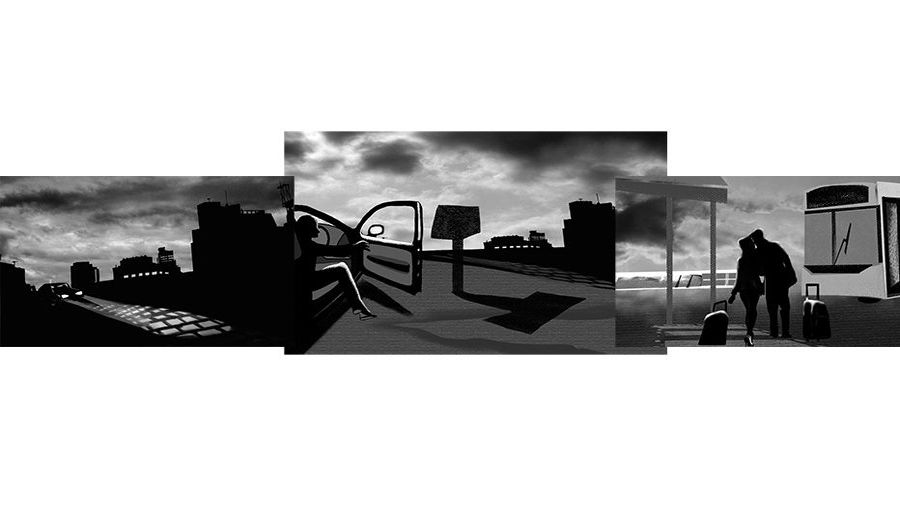Studio philosophy
‘Seeing comes before words’ John Berger
This studio examines the craft of telling stories through orchestrating visual narratives, to provide illuminating filmic worlds both fictional yet real. The diversity associated with this type of graphical practice includes children’s books, comic or cartoon strips, graphic novels, storyboarding, animation, film design and advertising.
The art of storytelling through sequential imagery for graphic designers and illustrators alike, is undoubtedly a practice within design that offers the most significant opportunities for authorship - a personal journey in conceiving an imagery tale; a personal expression of choice as creator and author. This studio allows the freedom to construct and compose imagery worlds using illustration, craft-based techniques, photography, print and type to explore a new visual syntax through elements of pace, suspense and rhythm. To develop a personal language that supports the conceptual processes associated with narrative fiction, concept art, animated films and broadcast sequences.
Project Brief
Illustration is about continual practice and recording. Within the studio, you will undertake a series of mini-projects that inform and challenge cultural and social awareness, both within popular and alternative opinion to develop a level of visual literacy that brings intellectual property to your illustrative practice:
Carnival – Pictorial Storytelling
Morris dancers/ raves/ festivals/ circus/ historical or religious events
Pictorial storytelling has been an essential factor in art history, demonstrated in many paintings and craft, illustrating folklore, legends, religious or historical events. Leonardo da Vinci remarked:
‘… and you who wish to represent by (solely) words the form of man and all the aspects… the more minutely you describe the more you will confine the mind of the reader, and the more you will keep him from the knowledge of the thing described. And so it is necessary to draw and describe…’
Producing a narrative theme around carnivals, you will begin to understand how to elevate the image into a storytelling vehicle more than mere decoration for text - to contextualize a message through a series of sequential images. We will ask you to study human behaviour and interaction to inform when representing emotive responses and to observe movements of dancer’s/actors/crowds to expose feelings and how to express them.
Fairy tale – Graphic Sequence
Within children’s illustration, it is the recipient who makes the necessary act of completion, the response based on intellectual curiosity – the urge to understand.
Sir John Tenniel’s artwork for Alice in Wonderland, instinctively relished the notion of children having a ‘dark’ and informed sense of humour, a fascination for the absurd and preposterous, an awareness of menace and strangeness.
Avoiding the idealised, candy-coloured pastiche and developing a unique visual language through experimental media, you will develop a storyboard for a child’s short story adaptation, from either Brothers Grimm’s fairytales or Edgar Allan Poe’s tales of the Grotesque, to match anything in the world of illustration for adults.
Moving Image – Animatic/ Animation
Mise en scene / art direction
In 1993, post-modern design was re-evaluated by designers who believed that beauty and structure was passé and ugliness was smart. The tense treatment and blatant manipulation of the medium within the credits for the film ‘Seven’, clearly captures the psychosis of the killer through hand-scratched and overlapping film effects.
You will be asked to translate your fairytale adaption into your own dark and distinctive animatic solution – using your own philosophical influences and evoking half-remembered dreams and childhood memories.
Workshops & Lectures
These mini-projects will be supported by life-drawing, visual literacy, reportage, printmaking, letterpress and digital illustration workshops and lectures around semiotics, sequential narrative, gestalt psychology, kinetic typography, storyboarding, neo-surrealism, conceptual art, film noir, post noir, title sequences, counter culture, etc.

Details
| Course | Graphic Design BA (Hons) Illustration BA (Hons) |
|---|---|
| Tutor | Adrian Beasley Michelle Salamon |
| Where | Studio 3, 6th Floor, Commercial Road |
| When | Tuesdays, Fridays |
Theodora Cican
Luke Fairhead
Nicole Francis
Tania Jonsson
Laura McDowall
Shauni Potton
Mark Rothwell
Gulan Saleh
Moses Adesanya
Haythem Mohamed Ali
Rebecca Appleyard
Nicole Becker
Santiago Cabrero
William Cook
Cindy Jane Doyle
Ashleigh Field
Surichha Gurung
Nadine Heim Hofers
Andzelika Jocyte
Salema Matlib
Anna Nguyen Minh
Naimah Ouafi
Erika Del Rosario
Chloe Saunders
Elizabeth Solari
Elson Vieira
Julia Wytrazek
Eleni Zakynthinou
